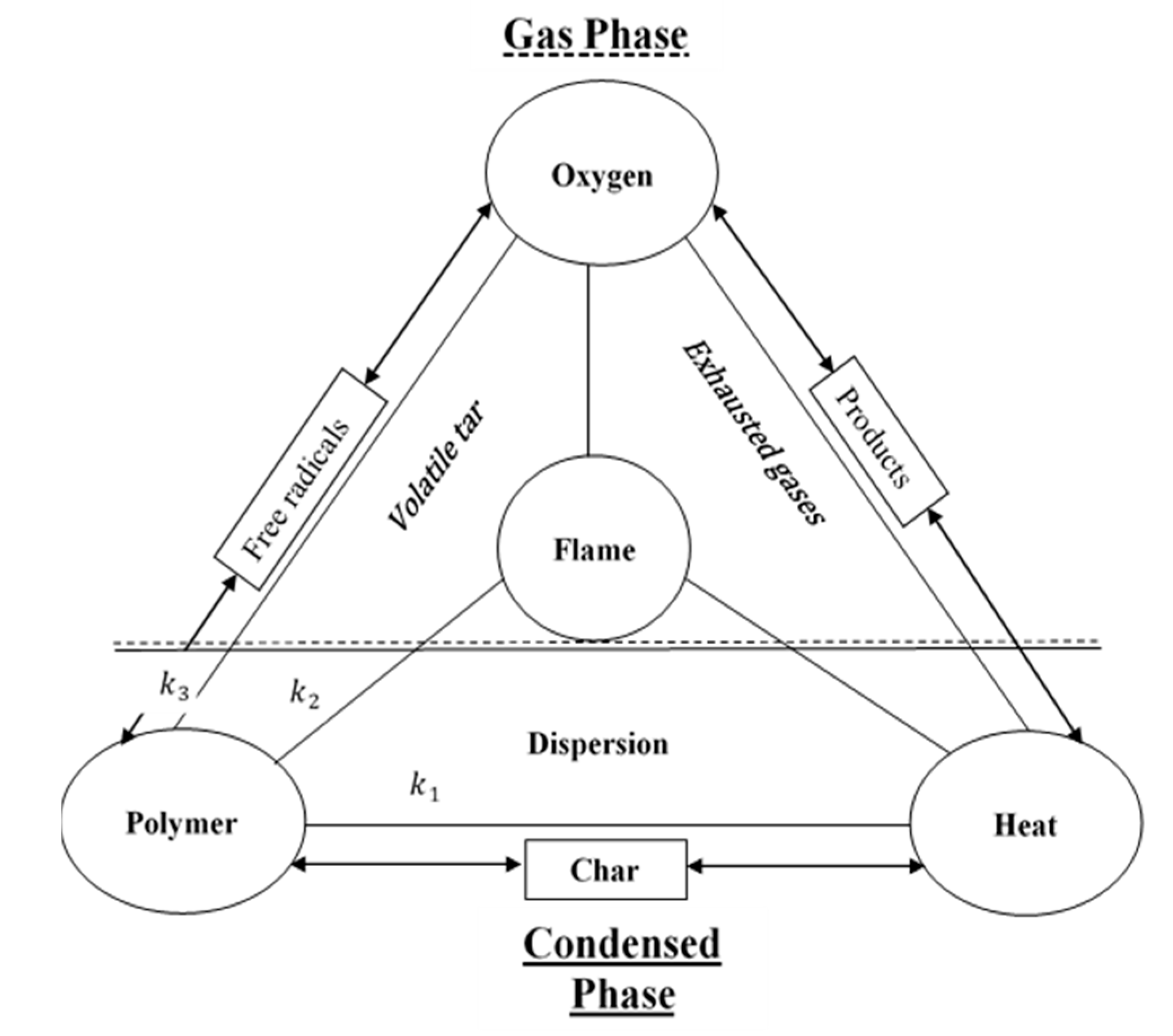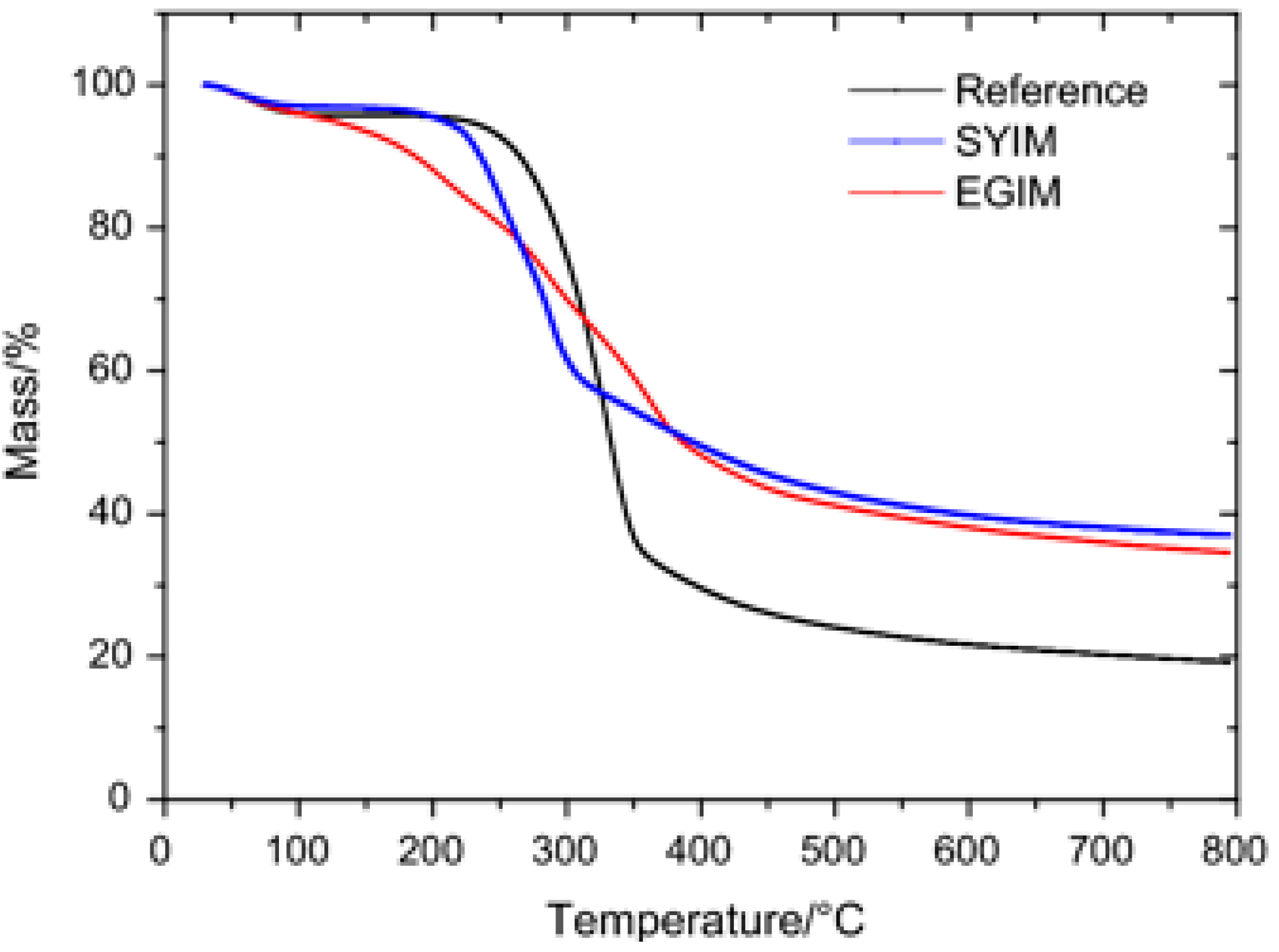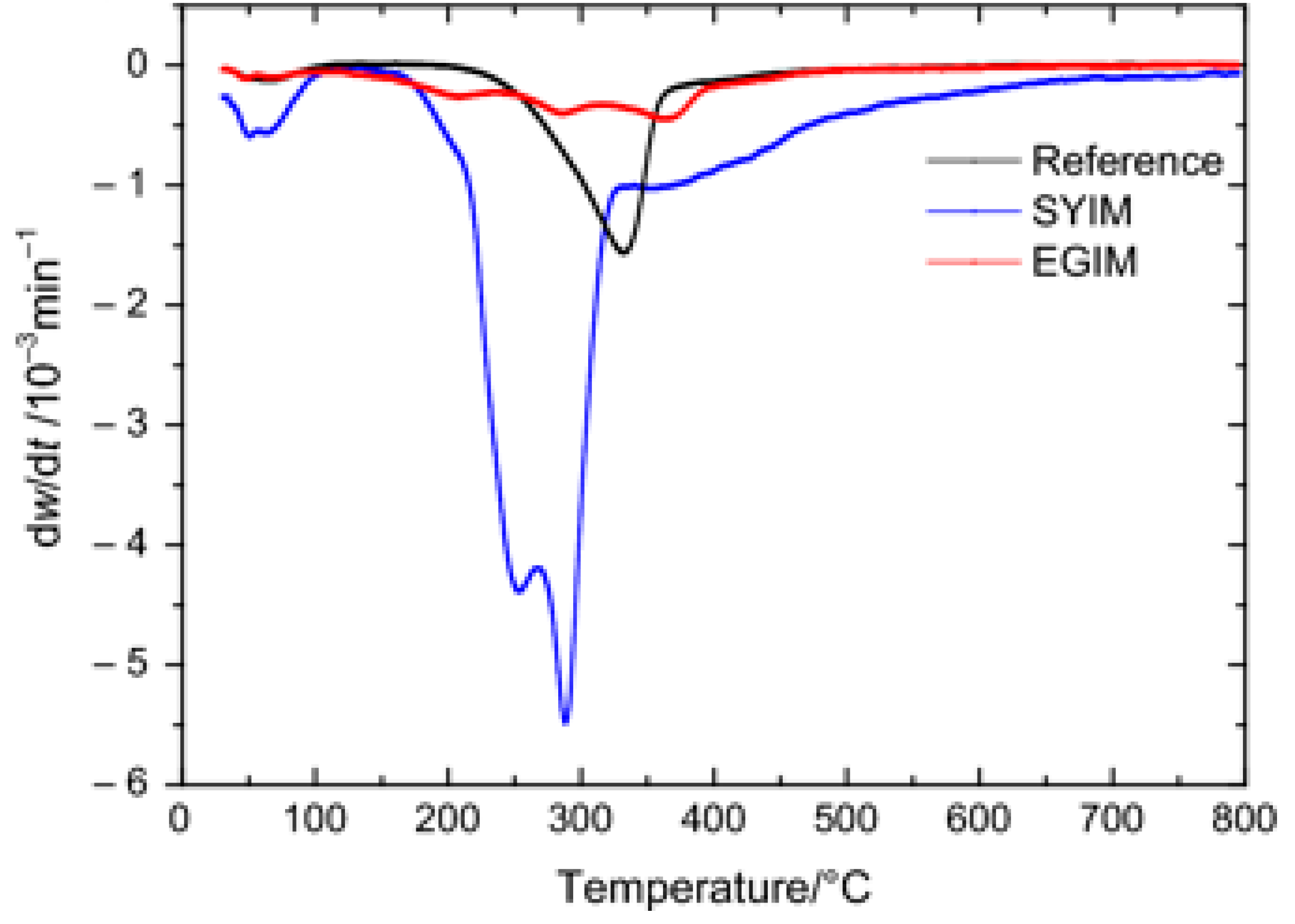Expandable Graphite as a Fire Retardant for Cellulosic Materials—A Review
Abstract
1. Introduction to the Mechanism of Fire Retardants
2. Combustion Properties of Cellulose
2.1. Combustibility of Cellulose
2.2. Thermal Decomposition of Cellulose
3. Expandable Graphite (EG)
4. Expansion Mechanism of EG
5. EG as Fire Retardant Additive in Different Materials
6. Conclusions
Author Contributions
Funding
Conflicts of Interest
References
- Beard, A.; Angeler, D. 17 Flame Retardants: Chemistry, Applications, and Environmental Impacts; Wiley: Weinheim, Germany, 2010; pp. 415–439. Available online: https://onlinelibrary.wiley.com/doi/abs/10.1002/9783527628148.hoc017 (accessed on 6 April 2020).
- Jesbains, K.; Faiz, A. The study of bonding mechanism of expandable graphite based intumescent coating. Res. J. Chem. Environ. 2011, 15, 401–405. [Google Scholar]
- Camino, G.; Costa, L. Performance and mechanisms of fire retardants in polymers—A review. Polym. Degrad. Stab. 1988, 20, 271–294. [Google Scholar] [CrossRef]
- Zheng, C.; Li, N.; Ek, M. Cellulose-fiber-based insulation materials with improved reaction-to-fire properties. Nord. Pulp Pap. Res. J. 2017, 32, 466–472. [Google Scholar] [CrossRef]
- Nazare, S. 14 Environmentally friendly flame-retardant textiles. In Sustainable Textiles: Life Cycle and Environmental Impact; Blackburn, R.S., Ed.; Woodhead Publishing Limited: Sawston, Cambridge, UK, 2009; Volume 32, pp. 339–368. [Google Scholar]
- Wilkie, C.A.; Morgan, A.B. Fire Retardancy of Polymeric Materials, 2nd ed.; CRC Press: Boca Raton, FL, USA, 2009. [Google Scholar]
- Camino, G.; Costa, L.; Di Cortemiglia, M.L. Overview of fire retardant mechanisms. Polym. Degrad. Stab. 1991, 33, 131–154. [Google Scholar] [CrossRef]
- Khan, M.; Ganster, J.; Fink, H. Natural and man-made cellulose fiber reinforced hybrid polypropylene composites: Effect of fire retardants. Adv. Mater. Res. 2007, 29, 341–344. [Google Scholar] [CrossRef]
- Feng, C.-M.; Zhang, Y.; Lang, D.; Liu, S.-W.; Chi, Z.; Xu, J.-R. Flame retardant mechanism of a novel intumescent flame retardant polypropylene. Procedia Eng. 2013, 52, 97–104. [Google Scholar] [CrossRef]
- Wladyka-Przybylak, M. Combustion characteristics of wood protected by intumescent coatings and the influence of different additives on fire retardant effectiveness of the coatings. Mol. Cryst. Liq. Cryst. Sci. Technol. Sect. A Mol. Cryst. Liq. Cryst. 2000, 354, 449–456. [Google Scholar] [CrossRef]
- Hao, J.; Chow, W.K. A brief review of intumescent fire retardant coatings. Arch. Sci. Rev. 2003, 46, 89–95. [Google Scholar] [CrossRef]
- Zhuge, J. Fire Retardant Polymer Nanocomposites: Materials Design and Thermal Degradation Modeling. Ph.D. Thesis, University of Central Florida, Orlando, FL, USA, 2012. Available online: https://stars.library.ucf.edu/cgi/viewcontent.cgi?referer=https://www.google.com/&httpsredir=1&article=3173&context=etd (accessed on 6 April 2020).
- De Araújo, M. Fibre science: Understanding how it works and speculating on its future. In Natural Fibres: Advances in Science and Technology Towards Industrial Applications; Springer Science and Business Media LLC: Berlin, Germany, 2016; Volume 12, pp. 3–17. [Google Scholar]
- Shen, D.; Xiao, R.; Gu, S.; Luo, K. The pyrolytic behavior of cellulose in lignocellulosic biomass: A review. RSC Adv. 2011, 1, 1641–1660. [Google Scholar] [CrossRef]
- Lowden, L.A.; Hull, T.R. Flammability behaviour of wood and a review of the methods for its reduction. Fire Sci. Rev. 2013, 2, 4. [Google Scholar] [CrossRef]
- Salmeia, K.A.; Jovic, M.; Ragaisiene, A.; Rukuiziene, Z.; Milasius, R.; Mikucioniene, D.; Gaan, S. Flammability of cellulose-based fibers and the effect of structure of phosphorus compounds on their flame retardancy. Polymers 2016, 8, 293. [Google Scholar] [CrossRef] [PubMed]
- Mazela, B.; Broda, M. Natural Polymer-Based Flame Retardants for Wood and Wood Products. 2015. Available online: https://www.researchgate.net/publication/282156040_Natural_polymer-based_flame_retardants_for_wood_and_wood_products (accessed on 18 May 2020).
- Shen, D.; Gu, S. The mechanism for thermal decomposition of cellulose and its main products. Bioresour. Technol. 2009, 100, 6496–6504. [Google Scholar] [CrossRef] [PubMed]
- Emmons, H.W.; Atreya, A. The science of wood combustion. Proc. Indian Acad. Sci. Sect. C 1982, 5, 259. [Google Scholar] [CrossRef]
- Duquesne, S.; Le Bras, M.; Bourbigot, S.; Camino, G.; Eling, B.; Lindsay, C.; Roels, T. Expandable graphite: A fire retardant additive for polyurethane coatings. Fire Mater. 2003, 27, 103–117. [Google Scholar] [CrossRef]
- Zabel, H.; Solin, S.A. Graphite Intercalation Compounds I: Structure and Dynamics; Springer Science & Business Media: Berlin, Germany, 2013; Volume 14, pp. 5–6. [Google Scholar]
- Thangamuthu, M.; Hsieh, K.Y.; Kumar, P.V.; Chen, G.-Y. Graphene- and Graphene Oxide-Based Nanocomposite Platforms for Electrochemical Biosensing Applications. Int. J. Mol. Sci. 2019, 20, 2975. [Google Scholar] [CrossRef]
- Yang, Q.; Geng, Y.; Dong, H.; Zhang, J.; Yu, X.; Sun, L.; Lu, X.; Chen, Y. Effect of environmental regulations on China’s graphite export. J. Clean. Prod. 2017, 161, 327–334. [Google Scholar] [CrossRef]
- Kutz, M. Handbook of Environmental Degradation of Materials; William Andrew: Norwich, NY, USA, 2012; Volume 3, pp. 367–385. [Google Scholar]
- Nguyen, H.D.T.; Nguyen, T.T.; Le Thi, A.K.; Nguyen, T.D.; Bui, T.P.Q.; Bach, L.G. The preparation and characterization of MnFe2O4-decorated expanded graphite for removal of heavy oils from water. Materials 2019, 12, 1913. [Google Scholar] [CrossRef]
- Zhao, H.; Pang, X.; Zhai, Z. Preparation and antiflame performance of expandable graphite modified with sodium hexametaphosphate. J. Polym. 2015, 1–5. [Google Scholar] [CrossRef]
- Zheng, C.; Li, N.; Ek, M. Mechanism and kinetics of thermal degradation of insulating materials developed from cellulose fiber and fire retardants. J. Therm. Anal. Calorim. 2018, 135, 3015–3027. [Google Scholar] [CrossRef]
- Krassowski, D.W.; Hutchings, D.A.; Qureshi, S.P. Expandable Graphite Flake as an Additive for a New Flame Retardant Resin; GrafTech International Holdings Inc.: Brooklyn Heights, OH, USA, 2012; pp. 1–6. [Google Scholar]
- Anielkis, B.; Wojciech, G.; Bartłomiej, M. Expandable graphite flakes as an additive for a new fire retardant coating for wood and cellulose materials—Comparison analysis. In Wood & Fire Safety; Springer Science and Business Media LLC: Berlin, Germany, 2020; pp. 120–124. [Google Scholar]
- Kim, J.; Oh, S.; Kim, H.; Kim, B.; Jeon, K.-J.; Yoon, S.-H. Expanding characteristics of graphite in microwave-assisted exfoliation. In Proceedings of the Scientiic Cooperations International Workshops on Engineering Branches, Istanbul, Turkey, 8–9 August 2014. [Google Scholar]
- Seredych, M.; Mikhalovska, L.; Mikhalovsky, S.; Gogotsi, Y. Adsorption of bovine serum albumin on carbon-based materials. C J. Carbon Res. 2018, 4, 3. [Google Scholar] [CrossRef]
- Paszkiewicz, S. Morphology and thermal properties of expanded graphite (EG)/poly (ethylene terephthalate) (PET) nanocomposites. Chemik 2012, 66, 26–30. [Google Scholar]
- Paszkiewicz, S.; Nachman, M.; Szymczyk, A.; Špitalský, Z.; Mosnacek, J.; Rosłaniec, Z. Influence of expanded graphite (EG) and graphene oxide (GO) on physical properties of PET based nanocomposites. Pol. J. Chem. Technol. 2014, 16, 45–50. [Google Scholar] [CrossRef]
- Pang, X.Y.; Song, M.K.; Tian, Y.; Duan, M.W. Preparation of high dilatability expandable graphite and its flame retardancy for LLDPE. J. Chil. Chem. Soc. 2012, 57, 1318–1322. [Google Scholar] [CrossRef][Green Version]
- Guo, C.; Zhou, L.; Lv, J. Effects of expandable graphite and modified ammonium polyphosphate on the flame-retardant and mechanical properties of wood flour-polypropylene composites. Polym. Polym. Compos. 2013, 21, 449–456. [Google Scholar] [CrossRef]
- Sami, U.; Faiz, A. The effect on expansion and thermal degradation of 63um expandable graphite on intumescent fire-retardant coating composition. Res. J. Chem. Environ. 2011, 15, 944–951. [Google Scholar]
- Sun, L.; Xie, Y.; Ou, R.; Guo, C.; Hao, X.; Wua, Q.; Wang, Q. The influence of double-layered distribution of fire retardants on the fire retardancy and mechanical properties of wood fiber polypropylene composites. Constr. Build. Mater. 2020, 242, 118047. [Google Scholar] [CrossRef]





© 2020 by the authors. Licensee MDPI, Basel, Switzerland. This article is an open access article distributed under the terms and conditions of the Creative Commons Attribution (CC BY) license (http://creativecommons.org/licenses/by/4.0/).
Share and Cite
Mazela, B.; Batista, A.; Grześkowiak, W. Expandable Graphite as a Fire Retardant for Cellulosic Materials—A Review. Forests 2020, 11, 755. https://doi.org/10.3390/f11070755
Mazela B, Batista A, Grześkowiak W. Expandable Graphite as a Fire Retardant for Cellulosic Materials—A Review. Forests. 2020; 11(7):755. https://doi.org/10.3390/f11070755
Chicago/Turabian StyleMazela, Bartłomiej, Anyelkis Batista, and Wojciech Grześkowiak. 2020. "Expandable Graphite as a Fire Retardant for Cellulosic Materials—A Review" Forests 11, no. 7: 755. https://doi.org/10.3390/f11070755
APA StyleMazela, B., Batista, A., & Grześkowiak, W. (2020). Expandable Graphite as a Fire Retardant for Cellulosic Materials—A Review. Forests, 11(7), 755. https://doi.org/10.3390/f11070755





